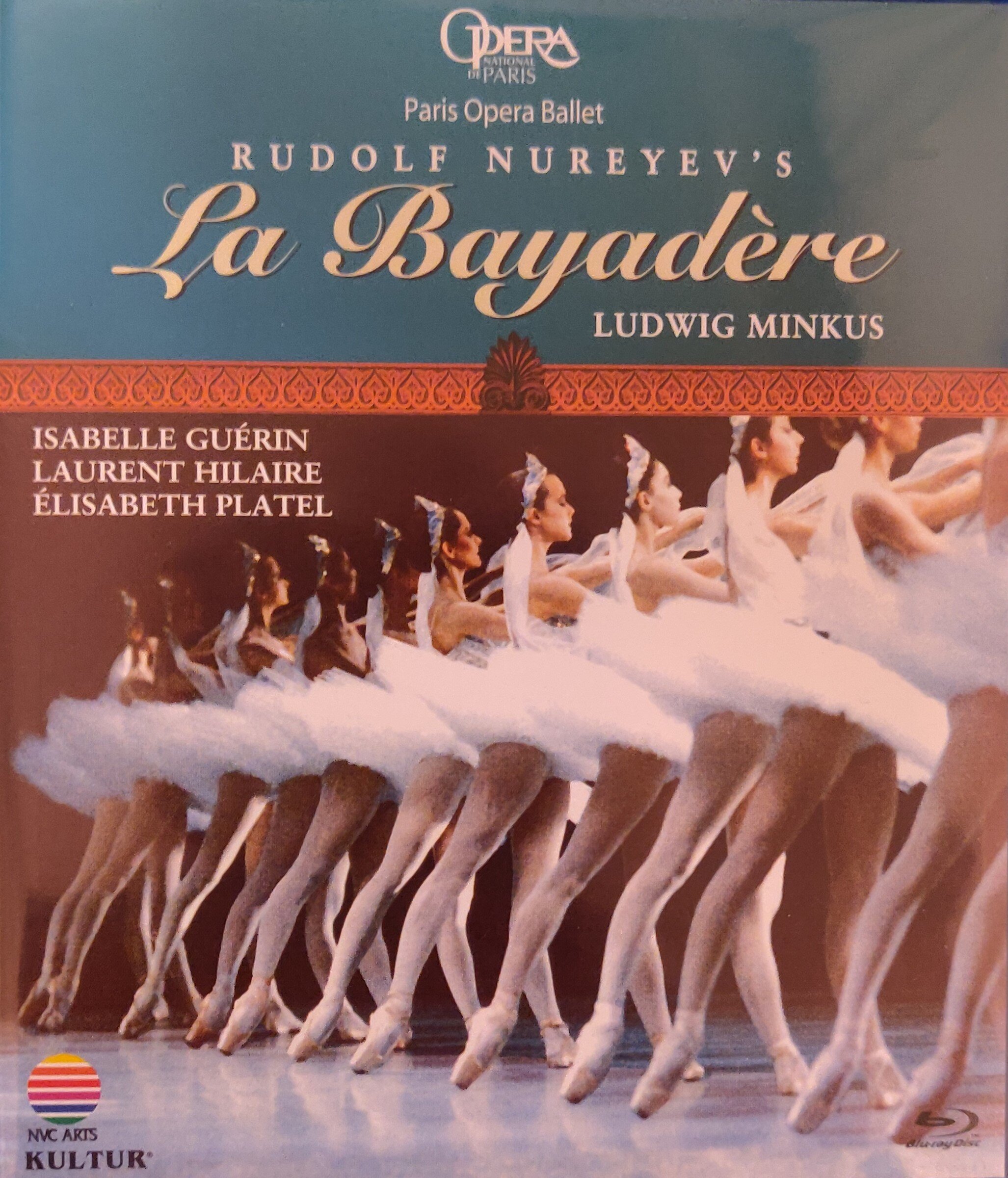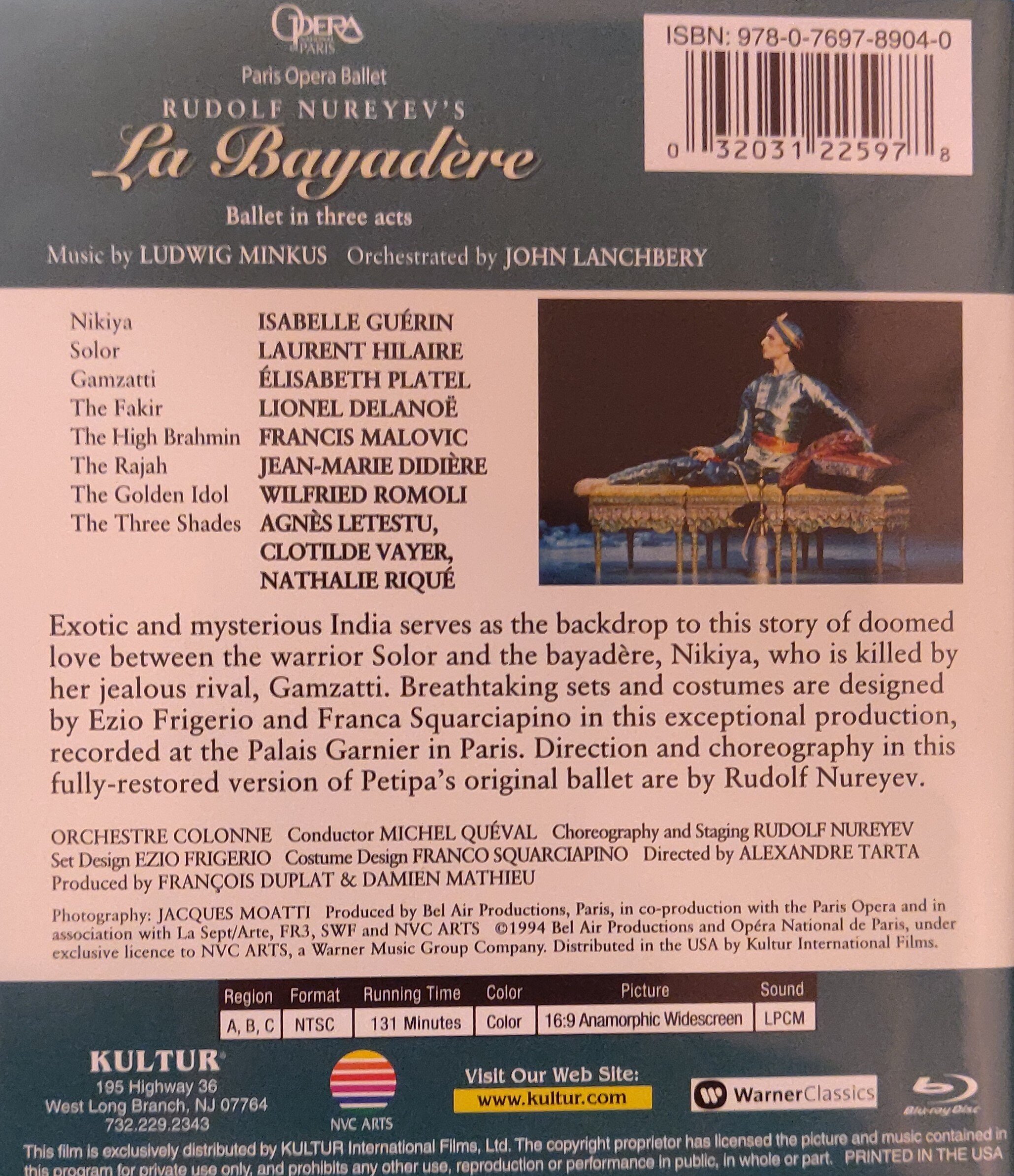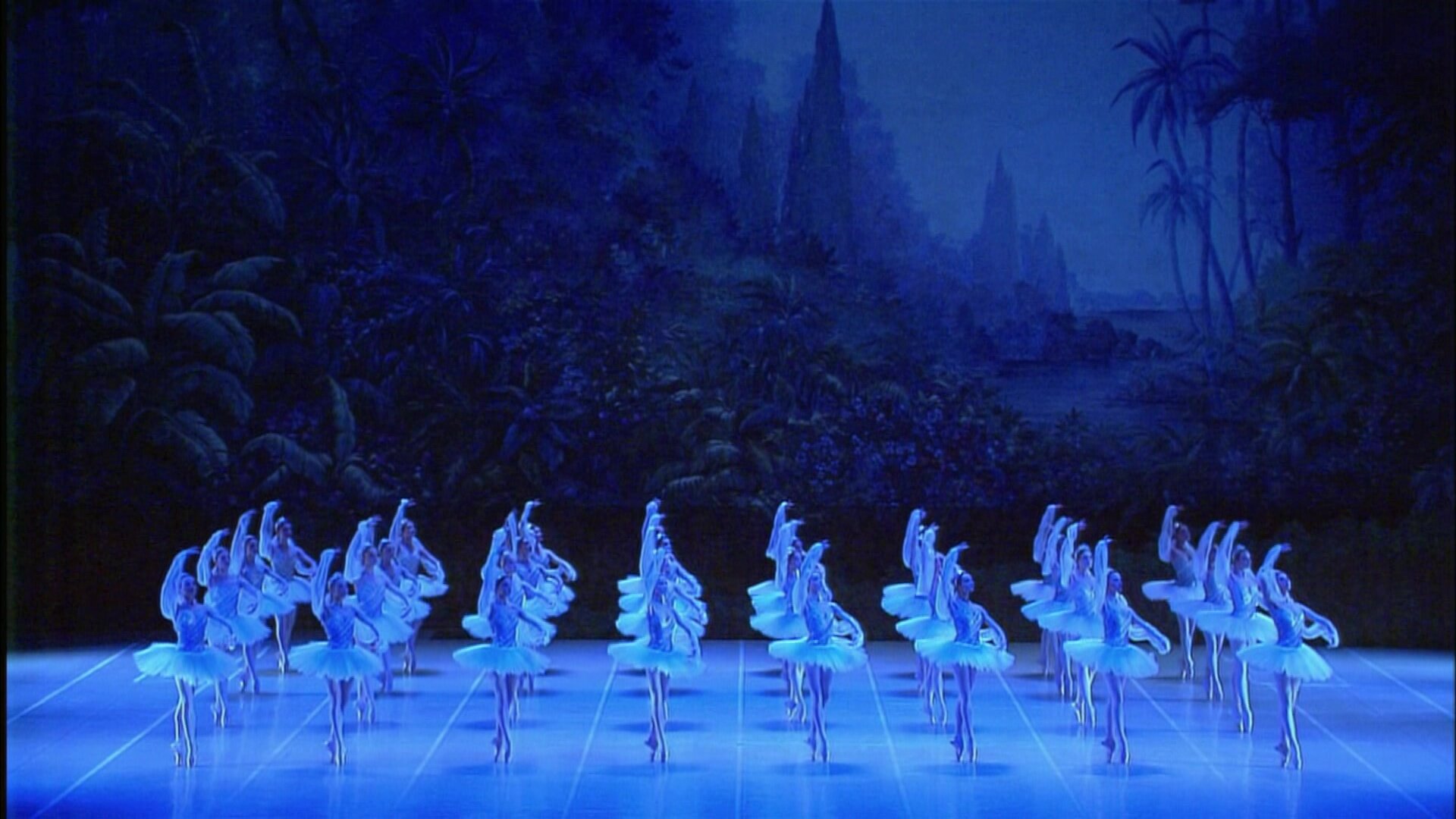

La Bayadère ballet. Music by Ludwig Minkus arranged by John Lanchbery. Choreographed by Rudolf Nureyev after Marius Petipa. Performed 1994 at the Paris Opéra Ballet. Stars Isabelle Guérin (Nikiya), Laurent Hilaire (Solor), Élisabeth Platel (Gamzatti, the Rajah's daughter), Francis Malovic (The High Brahmin), Jean-Marie Didière (Rajah), Lionel Delanoê (Maghaveya, the Head Fakir), Wilfried Romoli (The Bronze Idol) as well as Agnès Letestu, Clothilde Vayer, and Nathalie Riqué (The Three Shades). Michel Quéval conducts the Orchestre Colonne. Set designs by Ezio Frigerio; costumes by Franca Squarciapino. Originally recorded by film director Alexandre Tarta on 35mm stock and later transferred to a video produced by François Duplat. Released 2010, disc has LPCM stereo sound only. Grade: A
This is a fine-art motion picture film originally made in 1994 to show in movie houses. There have been quite a few of such movies made over the years. Many of those films are still available today thru Criterion etc. But this is one of only several fine-arts movie to be remastered to video well enough to take advantage of Blu-ray presentation (as opposed to the VHS or DVD). Video resolution in subject title is better than DVD but not as good as typical HDVDs released from 2010 on. Because this was made to be shown in movie houses, it only has stereo sound. Long ago we excluded this title for age and stereo only. But recently Wonk Zach Farr argued that we should cover this and sent us his copy of the disc to review.
We then decided to make an exception for this title mainly because of the extraordinary investment made by the Paris Opera Ballet to help make Nureyev’s last major production a monumental success. The Nureyev Bayadère premiered in 1992, Nureyev died in 1993, and subject recording was made a year later. So this title might be considered as a kind of memorial to Nureyev from the people he mentored at the Paris Opéra Ballet.
Our first screenshot takes us to ancient India and we meet the High Brahmin Priest (Francis Malovic) with some of his temple dancers:
The High Priest is enchanted by the new lead temple dancer, the Bayadère (Isabelle Guérin):
Although admired for her beauty and talent, the Bayadère is a commoner and a servant—a chief duty is to bring water to the fakirs. The Bayadère is in love with Solor (Laurent Hilaire), a hunter who kills tigers with his spear:
The High Priest offers riches to the Bayadère if she will accept his advances, but she refuses because she loves Solor:
Now we are at the palace of the Rajah, who is seated in the right below. He is a dance fanatic. On the extreme right is a tall painting of Solor, whose valor has made him a favorite of the Rajah:
A near-shot of two of the eight D’Jampe dancers, part of the Rajah’s harem:
The Rajah (Jean-Marie Didière) wants his daughter Gamzatti (Élisabeth Platel) to marry Solor. Gamzatti is thrilled with this prospect. The hero, swept away by this good fortune, abandons his pledge to the Bayadère:
The High Brahmin warns the Rajah that Solor is pledged to the Bayadère. The High Brahmin expects the Rajah to send Solor away. But the Rajah is more inclined to get rid of the Bayadère. On her own, Gamzatti tries to bribe the Bayadère into relinquishing her rights to Solor. The Bayadère responds by attacking Gamzatti (unsuccessfully) with a knife!
The wedding party for Gamzatti and Solor begins. Below left the bride arrives. Solor arrives on an elephant:
There follows a show for the court with lots of dancing acts:
Below is Wilfried Romoli as The Bronze Idol:
And here a wedding pas de deux for the lucky couple:
The Bayadère has to dance, but her grief threatens to ruin the party. The Rajah orders Gamzatti’s servant to give the Bayadère a basket of anointed flowers that she must smell and then dedicate to the newly-weds:
But hidden in the flowers is a deadly snake! The Bayadère dies before the guests, and Gamzetti gets Solor!
Solor is now a member of the royal family, but the price is guilt, guilt, guilt. Seeking relief in opium, he has a vision of the shades of ruined girls. The house provides only 1 ramp, but there is a full white corps of 32 dancers:
The Paris Opéra Ballet women are splendid, and Nurejev puts them through a huge number of formations:
Below four images from the grand pas de deux:
And before the shades retreat, dancers on the way up get a chance at solos. Below is Agnès Letestu, then age 23 in the role of The First Shade. She later went on to fame staring in such works as the Paris Opera Ballet Swan Lake and La Dame aux Camelias. Dancers are artists first, of course, but they are also athletes. It takes until about age 23 to learn the craft, and then they have about 17 years—to age 40—when they are worn out and have to retire:
After the Three Shades dance, the grand pas de deux comes to an end and the curtain falls to end the show. What happens to our protagotists? Well this is Nurejev so we just know that Solor will dissipate his life in a drug miasma, Gamzatta will drown, the Rajah will be defeated in battle by his cousin from the neighboring state and staked out to be eaten by ants, and the harem will be sold at the slave market. Enjoy what glories are offered you by life while you can.
Here are some comments from Zach:
“This was filmed in '94 which is before the advent of high definition digital cameras; which means it was captured on 35mm film. Unfortunately the digitization process by which each individual film cell is scanned onto a computer was also likely done sometime in the 90s or early 2000's. The resulting picture we get on the Blu-ray is not perfect, but is leagues better than DVD and compares favorably with more recent titles. In fact all the closeups and nearly all of the midrange shots look really good, some of them even excellent. It's only the full-stage shots that are a little soft in appearance and seem to be lacking in fine detail.
The editing consists largely of fades with fewer hard cuts (Vincent Battalion employs this technique sometimes). While this was distracting for me on occasion I think overall it actually helped enhance the atmosphere of the ballet and in some cases probably made cuts much less jarring than they otherwise would have been. My reasoning being that if you more slowly fade out of one image then into another it gives your brain and eyes a little extra time to process the new information and readjust yourself. I think the audio sounded good, and was clearly a high quality recording although I did have to turn the volume up higher than I normally would to produce similar results. It's strange not having the applause come from the side speakers, didn't think I would notice that but it stood out to me.
I'm really glad I decided to take a chance with this older title as it has skyrocketed to one of my favorites. The dancing is absolutely top tier, the sets are grand, costumes are stunning, and the POB corps de ballet put every other company I've seen to shame. What really sold it for me though was the white act. I prefer the La Bayadère white act to that of Swan Lake, and I thought this was the best I've seen. In fact right after I watched it I busted out all my other copies of La Bayadère and watched portions of their white acts followed by another viewing of this POB white act. No competition in my mind, it has this wonderful mysterious dream-like quality to it that none of the other titles I have can quite manage to achieve. Even the white act in the Bolshoi release (as great as it is) seems somewhat dull and plain in comparison.”
Thanks again, Zach for these comments. This inspired me to grab a Wonk Worksheet and run the numbers on this movie filmed by Alexandre Tarta long ago. A healthy 76% of the clips show the whole bodies of the dancers. It would not be exactly logical to speak of DVDitis when judging this title since Tarta filmed this 1994 and the DVD format was introduced three years later. But I note that pace of Act 1 is too fast for our taste with an average clip lasting only about 6 seconds. Act 2 is a bit better at about 8 seconds per clip. But the Act 3 white act has a magnificent pace of about 15 seconds. The pace over the entire disc is 8.7 seconds. By our standards, the movie is a bit too hot. It suffers from what we call DVDitis. Looking again at the numbers, I also note that this is probably the longest La Bayadère we have with 112 minutes of actual dancing on the disc—Nureyev wants you to see it all!
Now to a grade. Starting with A+, I reduce for weak PQ, the fast pace, and lack of surround sound to a B. But I yank the grade back up to A in appreciation of the production values that impressed Zach so much.


























